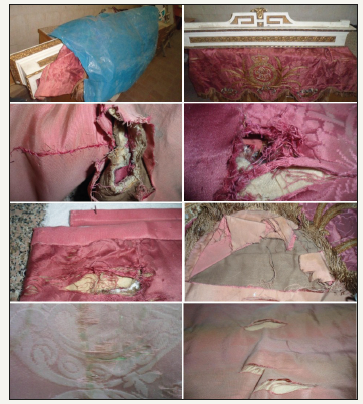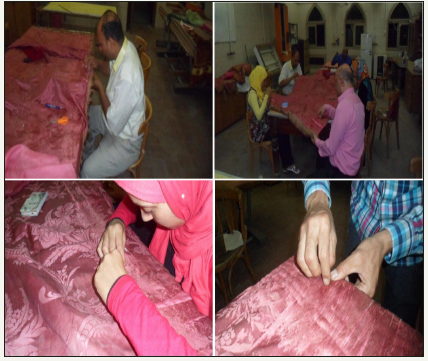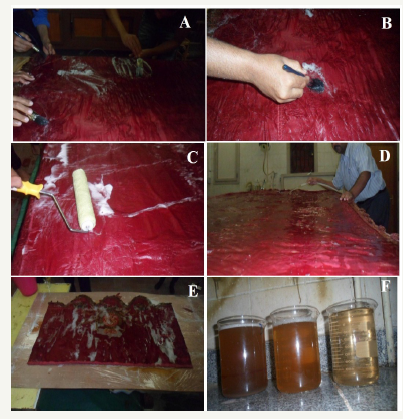- Submissions

Full Text
Trends in Textile Engineering & Fashion Technology
Restoration Strategy of a Rare Historic Curtain in Cairo University, Practical Applications
Harby E Ahmed*
Department of Archeology Conservation, Faculty of Archeology, Cairo University, Egypt
*Corresponding author: Harby E Ahmed, Department of Archeology Conservation, Faculty of Archeology, Cairo University, Egypt
Submission: December 31, 2018;Published: January 11, 2019

ISSN 2578-0271 Volume4 Issue5
Abstract
Historical curtains that are still being used are subject to many damage conditions. Where it affected by the fluctuation in temperature and humidity. In addition, the effect of light, air pollution, misuse as damage factors. The historical curtain in the royal chamber of the Cairo University contains many damage aspects such as stain, dirt, separate parts, missing parts, change in color, and general weakness. A close examination was conducted to determine the type of curtain materials, and the damage aspects. The scientific documentation of the historical curtain was carried out before conservation process .In the begging, the strengthening of the weak and separate parts was carried out prior to the washing operations. Test of color degree stability was conducted for washing solutions. Mechanical cleaning, wet cleaning, sterilization, drying of the historical curtain were carried out using scientific methods. Final installation using silk thread and needle, and by reinforced by polymer adhesion. Restoration operations were recorded by photography.<./
Keywords: Historical curtain; Light; Deteriorations; Cleaning; Support SEM
Introduction
Historical curtains are a very important part of historical textiles that are found in museums and historic houses. These curtains have different motifs in varying shades of color, representing the age of the period in which they established. Curtains are exposed to many different deterioration factors that cause them weakness and change color grades. Silk represents the main material for the manufacture of historical curtains [1-10].
Figure 1:show details of historical curtain. One can see the bad storage of the object, deterioration aspects such as separate parts, separate threads, dirt, and stain.

The object
The historical curtain is located in the royal chamber attached to the major celebrations hall in Cairo University. The curtain date back to the family of Mohammed Ali (late Ottoman era). The curtain has been subjected to many different damage factors, which caused decay and change in color grades. The curtain consists of three main parts; the upper part and two-side parts along the curtain. A previous restoration process was done to the historical curtain and re-use again. The curtain consists of three layers, which the first layer made from silk fabrics. The curtain is decorated with edges by adding decorative strips. The curtain was suspended with a plastic sling on a wooden display. A false fixation of the curtains was observed using stainless screws. A change in the degree of acidity of the historical carpet resulted in chemical damage. Historic curtain is subject to restoration processes to get rid of dust, stains, impurities and acidity. Figure 1 present a more details of the historical object.
Documentation of the object
Visual examination: A visual examination of the historical object done by the eye in order to record the different type of deterioration. It is appearing for the reader the missing parts, some type of dirt and stain as shown in Figure 1.
Morphological and dirt examination: Identification of historical object materials such as kind of fibers is a very important step. Furthermore, identification of dirt, stain and deteriorations components help the conservators to make a strategy of conservation and chosen of conservation materials and solutions. Scanning electron microscopy with energy-dispersive X-ray spectrometry (SEM/EDS) is the most frequently used analytical technique. It is appearing for the reader that the fibers is silk. In addition, one can see the damages of the fibers that that nobody can see it by the naked eye as shown in Figure 2A [11-14].
By other words, scanning electron microscopy with energy dispersive X‐ray spectrometry (SEM/EDS) is a used to identify type of dirt and stain that found in the crystalline form. The samples investigated by using a Quanta 200 ESEM FEG from FEI Scanning Electron Microscope (SEM) as shown in Figure 2B [15-18].
Figure 2:A. Show the silk fiber of the front layers of the curtain,
B. XRF of dirt and attain that found on the object.

Testing the stability of dyes: Testing of pigment fastness before washing is one of the most important steps. The process was done by immersing a piece of cotton wrapped round a wooden stick into the cleaning solutions and placing it in contact with the colorful parts of the ribbons, each color was individually tested. It was found that all the dyes were stable and did not bleed with the wet cleaning solution [19,20].
Strengthen and support the weak and separate parts:
The historical curtain contains many separate parts and threads. Therefore, Installation and reinforcement of these separate parts and threads must be carried out before cleaning process. The stitching technique was used to strengthen and fix the separate parts and threads in the front of the curtain to the historic curtain body. Stitching was done by using silk thread and narrow needles. For the separate parts and threads in the back of the curtain. The BEVA 371 adhesive has been applied to modern silk fabric. The separate parts were fixed using the adhesive method as shown in Figure 3 [21,22].
Figure 3:Show the team during the Installations, support and fixing of the weak, separate parts and threads before the cleaning process by using dyed silk fibers with needles.

Mechanical cleaning
A very important stage in the restoration and maintenance of historical curtains. The cleaning was done by using various soft brushes to remove the dust that is not chemically attached to the surface of the curtain. The cleaning was done with great care to the historical curtain of the front and rear layers. After this step, the historic curtain is ready for wet cleaning process. Some of the separate parts have been repositioned to the outer curtain body after mechanical cleaning [23-25].
Wet cleaning
Figure 4:A & B: Show the wet cleaning process by using brushes with water and neutral detergents.
D: Final wash bath of cleaning by using water only
E: Show the cleaning of the upper part of the Historical curtain
F: Remaining leaning solution that contain the dissolved dirt and satin after different washing baths.

Wet cleaning operations are done with extreme care and care. It will be dangerous for the historic curtain to cleaning it using soak or flood in a water bath according to bad condition of the object. The curtain was put over a wooden stand and the washing process was done by using water and neutral detergents equivalent with the brushes of different sizes in order to get rid of the emitters difficult to remove. The washing stages have been repeated until complete elimination of the dirt and stain. This is indicated by cleaning solutions after washing. The last wash bath using water only to help remove the residues of washing solutions and residues of dissolves dirt and stain as shown in Figure 4 [26-28].
Drying process
Figure 5:A: Show the drying process of the historical curtain after wet cleaning process by using free acid textile
B: Drying process by warm air by using heaters

Drying of historical textiles after wet cleaning processes is an important step in order to keep textiles from the expected damage witting. In the case of long-term wetting, may cause the emergence of innate growths and the possibility of decay some of the weak components in the historical curtain. After the wet cleaning process, the historic curtain was drained in two ways. The first absorption of remaining water residue after washing by non-acidic textiles prepared for the processes of drying and water absorption from Historical objects. The second way, drying by the air and it used the heaters around the object to raise the temperature room, which will help accelerate the evaporation of water left by the historical curtain. One can see the dying process as shown in Figure 5 [9,29].
Final support and fixing
After finishing the wet cleaning of the historical curtain, the final supporting and fixing of the separate parts, and threads shall be performed. Two ways were used to reinforce and fix the separated threads and parts. The first method, using narrow stitches by dyed silk threads and needles for the front layer of the historical curtain. The second method of installation is adhering method by using polymer adhesive BEVA 371. For the second method, firstly, dyeing new silk fabric was done, and then applied the adhesive on the dyed silk fabric. The treated silk fabric by adhesive was cut into small parts according to the size of the buds in the curtain body. The silk fabric pieces were placed under the separated parts. In order to adhere the separate parts, the thermal furnace was used. The wooden stand was cleaned by using mixture from distilled water and alcohol. Fortunately, the wood carrier was in a good condition and it isn’t needed different restoration process. Some plastic rings have been changed and the curtain is attached to a new one of the same types as the old rings. The decoration at the edges of the historic curtain was cleaned and treated (Figure 6 & 7) [1,30-32].
Figure 6:A: Show the dyeing process of the silk threads and silk fabric
B-D: Final support and fixing of separate threads and parts by stitching method

Figure 7:Show the support and fix the separate parts by using adhesion method
A: The separate parts after treatment by using adhesive
B: The cleaning and other restoration process of the wooden carrier
C: The upper part of historical curtain after conservation process.

Conclusion
Historical curtains are exposed to many different types of deterioration factors, which cause a damage aspect and weakens of the historical curtains. Exposure to light cause fading of color degree. Also exposed to dust and staining, which work to darken the color. Scientific examinations and documentation of historical curtains must be carried out prior to restoration. A necessary support and fix of the separate parts and threads must be done before cleaning process to keep the curtains from damage during washing process. Recording of restoration steps is done using photography.
References
- Pow CV (1970) The conservation of tapestries for museum display. Studies in conservation 15 (2): 134-153.
- Tímár-Balázsy Á, Eastop D (1998) Chemical principles of textile conservation. Routledge, Abingdon, UK.
- Landi S (1992) The textile conservator’s manual. (2nd edn), London, UK, pp. 120-123.
- Ahmed H (2009) History of natural dyes in north Africa ‘Egypt’. In: Thomas Bechtold, Rita Mussak- John Wiley & Sons (Eds.), Handbook of Natural Colorants, UK, p. 27.
- Ahmed H, Reda S, Yehia D, Ziddan Y (2016) Preventive conservation of historic textile from the ultraviolet degradation due to light exposure in Egyptian museums. International Journal of Materials Science and Applications 5(6): 10-14.
- Attia N, Yehia D, Hassan M, Ahmed H, Zidan Y (2015) Novel synthesis of nanoparticles-based back coating flame-retardant materials for historic textile fabrics conservation. Journal of Industrial Textiles 46(6): 152.
- Mansour M, Ahmed H (2012) Occurrence of fungi on some deteriorated ancient Egyptian materials and their controlling by eco-friendly products. Egyptian Journal of Archaeological and Restoration Studies 1(1): 91-101.
- Fierascu I, Fierascu RC, Fotea P (2019) Application of Fourier-Transform Infrared Spectroscopy (FTIR) for the Study of cultural heritage artifacts. In VR Technologies in Cultural Heritage: First International Conference, VRTCH 2018, Brasov, Romania.
- Amin EA (2018) Conservation of a gauze textile from the tulunid period in Egyptian textile museum, CAIRO. International Journal of Conservation Science 9(1).
- Petrov J (2019) Fashion, history, museums: Inventing the display of dress. Bloomsbury Publishing, UK.
- Ahmed H (2014) A new approach to the conservation of metallic embroidery threads in historic textile objects from private collections. International journal of Conservation science 5(1): 21-34.
- Ahmed H (2011) Strategy for preservation of Ptolemaic wrapped Mummy’s linen in tuna el-Gebel excavation, Egypt: A case study. International journal of Conservation science 2(3): 155-164.
- Batcheller JC (2005) Optical and scanning electron microscopy techniques for the determination of hair fibres from Romano-Egyptian textiles. In Scientific analysis of ancient and historic textiles: informing preservation, display and interpretation: postprints, first annual conference, 13-15 July 2004. Archetype Publications, London, UK.
- El enen Amin (2018) The mechanism of deterioration, treatment and display of historical decorated silk textile. Journal of Textile and Apparel, Technology and Management 10(4): 1-14.
- Nassef OA, Ahmed HE, Harith M (2016) Surface and stratigraphic elemental analysis of an ancient Egyptian cartonnage using Laser- Induced Breakdown Spectroscopy (LIBS). Analytical Methods 8(39): 7096-7106.
- Ahmed H, Nassef OA (2013) From Ptolemaic to modern inked linen via laser induced breakdown spectroscopy (LIBS). Analytical Methods 5(12): 3114-3121.
- Hložek M, Trojekb T, Prokešb R, Linhartb V (2019) Mediaeval metal threads and their identification using micro-XRF scanning, confocal XRF, and X-ray micro-radiography. Radiation Physics and Chemistry 155: 299-303.
- Botto A, Campanella B, Legnaioli S, Lezzerini M, Lorenzetti G (2019) Applications of laser-induced breakdown spectroscopy in cultural heritage and archaeology: a critical review. Journal of Analytical Atomic Spectrometry 34: 81-103.
- Fiette A (1997) Tapestry restoration: an historical and technical survey. The Conservator 21(1): 28-36.
- Portalés C (2018) Interactive tools for the preservation, dissemination and study of silk heritage-An Introduction to the SILKNOW Project. Multimodal Technologies and Interaction 2(2): 28.
- Quye A, Lennard F (2015) Materialising conservation science research for historical textiles. In: 1st International Conference on Science and Engineering in Arts, Heritage and Archaeology (SEAHA), London, UK.
- Karimnejad M, Boyaghchi M, Zolfaghari B (2018) Evaluation and optimization of acanthophyllum extract in washing of the historical textiles. International Journal of Applied Arts Studies (IJAPAS) 2(4).
- Ahmed H, Gremos S, Kolisis F (2010) Enzymatic removal of the oily dirt from a coptic tunic using the enzyme lipase. Journal of Textile and Apparel, Technology and Management 6(3): 1-17.
- Aslanidou D, Tsioptsias C, Panayiotou C (2013) A novel approach for textile cleaning based on supercritical CO2 and Pickering emulsions. The Journal of Supercritical Fluids 76: 83-93.
- Crawford D, Lynch J, Whipps J, Ousley M (1993) Isolation and characterization of actinomycete antagonists of a fungal root pathogen. Applied and environmental Microbiology 59(11): 3899-3905.
- Mason TJ (2016) Ultrasonic cleaning: An historical perspective. Ultrasonics sonochemistry 29: 519-523.
- Ahmed H (2013) Identification and conservation of a rare islamic textile decorated with metallic yarns. Egyptian Journal of Archaeological and Restoration Studies 3(1): 109-118.
- Ghosh A (2017) Soiling on traditional and historical textiles-a glimpse on cleaning procedures. 3(7): 1103-1106.
- Ahmed H (2012) First aid of rare ptolemaic textile in tuna el-gabel excavation, Egypt, e- Conservation magazine 23: 78-89.
- Pooja S, Ekta S, Nargis F (2017) A case study on conservation of textiles in Allahabad museum, Uttar Pradesh. Asian Journal of Home Science 12(1): 296-303.
- Lorenz KM (2018) Creating a textile museum exhibit: Conservation and Accessibility. This research is a product of the graduate program in Visual Art & Design at Andrews University.
- Chanialaki T, Vanden Berghe I, oudin M, Margariti C (2018) The hopeful reunion of the floating heads: the conservation of two textile fragments and their possible association with a third. Journal of the Institute of Conservation 41(2): 1-15.
© 2018 Harby E Ahmed . This is an open access article distributed under the terms of the Creative Commons Attribution License , which permits unrestricted use, distribution, and build upon your work non-commercially.
 a Creative Commons Attribution 4.0 International License. Based on a work at www.crimsonpublishers.com.
Best viewed in
a Creative Commons Attribution 4.0 International License. Based on a work at www.crimsonpublishers.com.
Best viewed in 







.jpg)






























 Editorial Board Registrations
Editorial Board Registrations Submit your Article
Submit your Article Refer a Friend
Refer a Friend Advertise With Us
Advertise With Us
.jpg)






.jpg)














.bmp)
.jpg)
.png)
.jpg)










.jpg)






.png)

.png)



.png)






